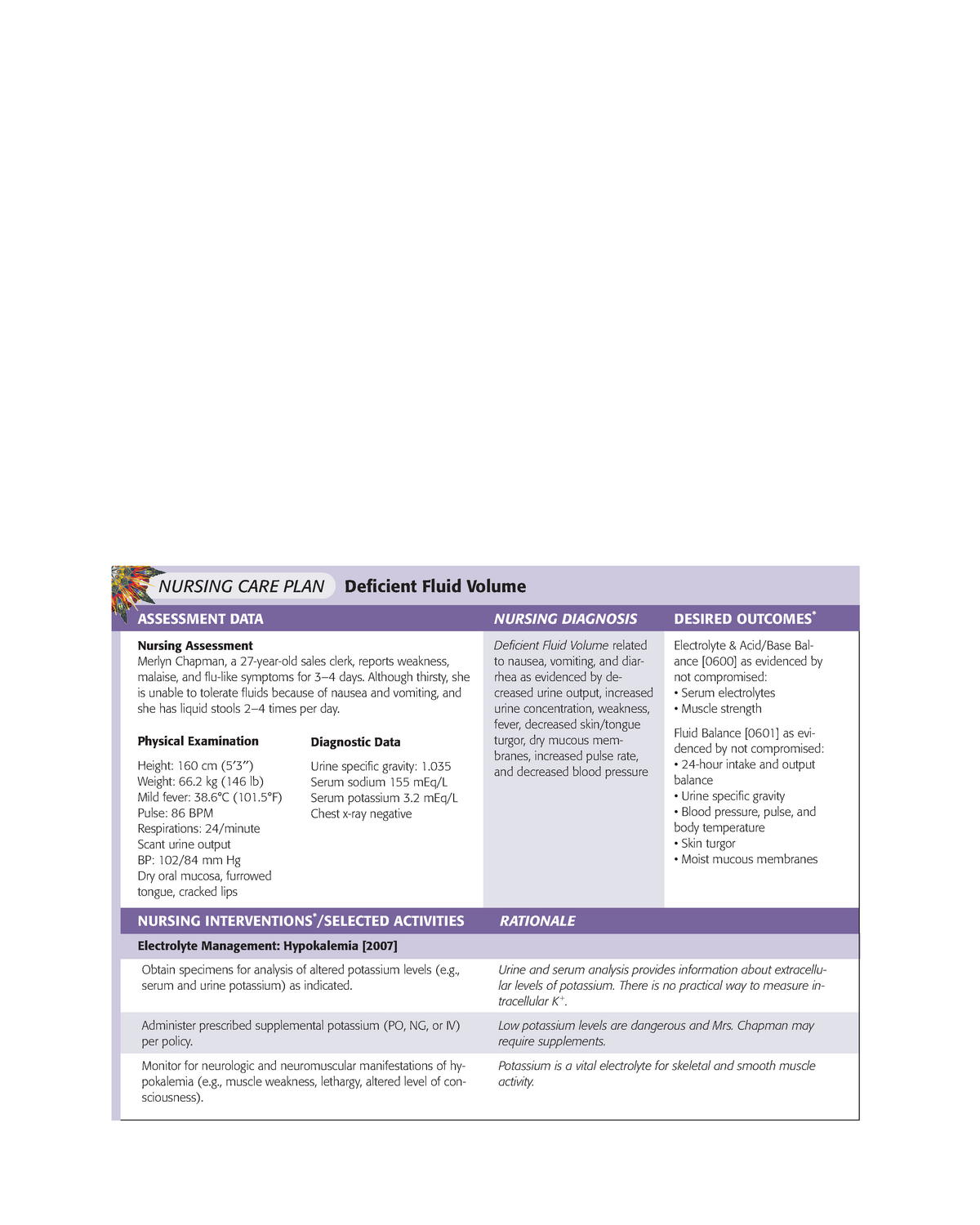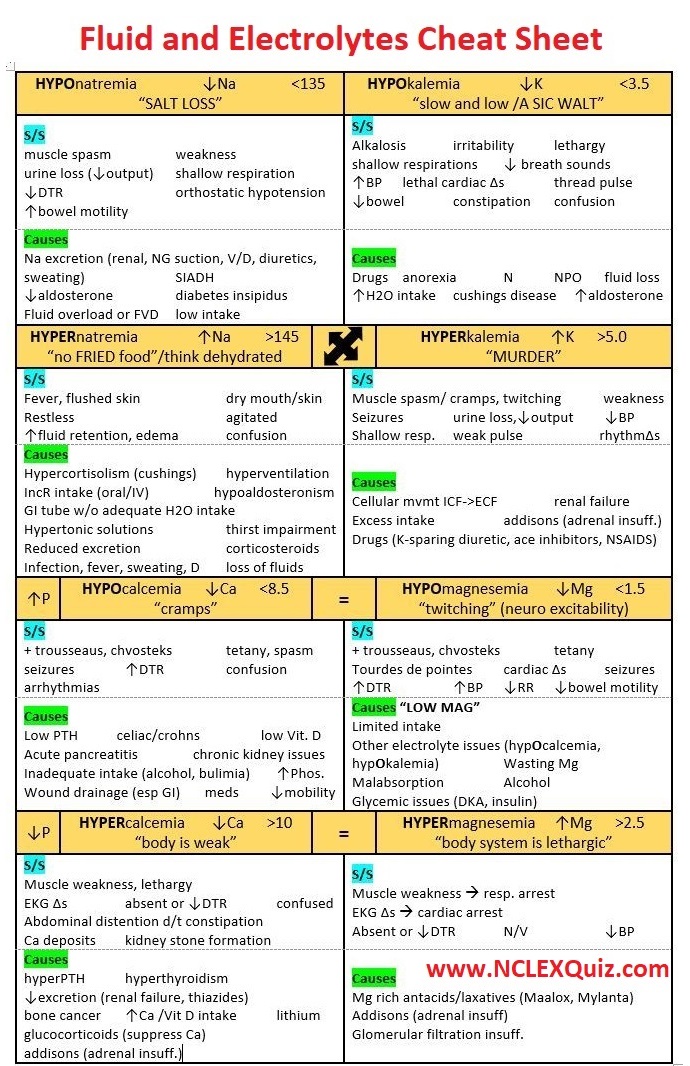
Fluid and electrolyte imbalance Care plan NURSING CARE PLAN Deficient Fluid Volume ASSESSMENT
There are many nursing diagnoses applicable to fluid, electrolyte, and acid-base imbalances. Review a nursing care planning resource for current NANDA-I approved nursing diagnoses, related factors, and defining characteristics. See Table 15.6c for commonly used NANDA-I diagnoses associated with patients with fluid and electrolyte imbalances. [12]

10 Fluid And Electrolyte Imbalances Nursing Care Plans Nursing care plan, Electrolytes
The balancing act. Fluid and electrolyte balance play an important role in homeostasis, and critical care nurses assume a vital role in identifying and treating the physiologic stressors experienced by critically ill patients that disrupt homeostasis. 1. Electrolytes, found in body fluids, are electrically charged particles (ions).

RiskForFluidAndElectrolyteImbalance Sample NCP PDF Electrolyte Intravenous Therapy
The nurse plans to educate the patient about signs and symptoms of fluid and electrolyte imbalance and when to contact the provider. Goals for a patient experiencing fluid, electrolyte, or acid-base imbalances depend on the chosen nursing diagnosis and specific patient situation. Typically, goals should relate to resolution of the imbalance.

Electrolyte Imbalance Nursing Care Plan
Table 15.6c provides a list of common NANDA-I nursing diagnoses related to fluid and electrolyte imbalances, such as dehydration, excess fluid volume, and risk for electrolyte imbalance. The table also includes the etiology, defining characteristics, and related factors for each diagnosis. This is a useful resource for nurses who want to identify and address the problems of their patients with.

Electrolyte Imbalance Care Plan Rose Pdf
Electrolyte Imbalance can be defined as the disproportion of electrolytes in the body which can affect the regulation of many bodily processes such as blood acidity and blood pressure, hydration status, nerve and muscle functions, and rebuilding of damaged tissues.

Major Fluid and Electrolyte imbalance signs and symptoms by nurses note Nurses Note
fluid and electrolyte imbalance as a delegated medical action. The North American Nursing Diagnosis Association's (NANDA) inclusion of nursing diagnoses related to fluid balance reflects nursing involvementin patientcare in this area. Development of a classification of nursing diagnoses is evolving through the work of NANDA. In 1982,

Nursing Care Plan for "Fluid and Electrolyte Imbalances"
Table 15.6d. Interventions for Imbalances. Nursing Diagnosis. Interventions. Excessive Fluid Volume. Administer prescribed diuretics to eliminate excess fluid as appropriate and monitor for effect. Monitor for side effects of diuretics such as orthostatic hypotension and electrolyte imbalances. Position the patient with the head of the bed.

10 Fluid And Electrolyte Imbalances Nursing Care Plans Nurseslabs Nursing care plan, Nursing
Buy Metrics Abstract Maintaining the balance of fluid and electrolytes is crucial to the care of patients across the continuum. To do this, a practitioner must be cognizant of key monitoring and assessment parameters.

Good to know Nursing school tips, Nursing school studying, Nursing school survival
Ashley's nursing care plan goal for this patient includes maintaining fluid volumes and laboratory values at normal levels. Ashley knows the two major types of fluid imbalances are volume and.

Fluid and Electrolyte Imbalance Chart Fluid/Electrolyte Imbalance Causes Signs/Symptoms Lab
Electrolytes are essential for health and well-being, so many changes to the body's function or organs can cause imbalances & caught by healthcare professional. A variety of factors cause electrolyte imbalance. Electrolyte poor dietary intake. Vomiting and diarrhea. Medicines (examples: diuretics, laxatives and other medications) Medical.

ER Fluid Additive Cheat Sheet Interventions for copd patient in respiratory failure
Updated: Apr 28, 2023 Published Mar 29, 2023 Workforce Development Columnist Melissa Mills, BSN Specializes in Workforce Development, Education, Advancement. This article was reviewed and fact-checked by our Editorial Team. Table of Contents Signs & Symptoms Assessment Factors Affecting Causes Treatments Complications Nurse's Role

Fluid and Electrolyte Imbalances Nursing cheat sheet Nursing Student www.tambonpasak.go.th
Causes Several factors can contribute to electrolyte abnormalities. Some of the potential causes include: Vomiting Diarrhea Excessive or insufficient fluid volume Other medical conditions (i.e. renal failure, congestive heart failure, hypothyroidism) Medications (i.e. diuretics) Signs and Symptoms Hypernatremia Excessive thirst Agitation

Nursing Diagnosis & Care Plan for Fluid and Electrolyte Imbalance Student’s Guide
Fluid and Electrolyte Imbalances: Interpretation and Assessment. 2016 Nov/Dec;39 (6):382-386. doi: 10.1097/NAN.0000000000000193. Maintaining the balance of fluid and electrolytes is crucial to the care of patients across the continuum. To do this, a practitioner must be cognizant of key monitoring and assessment parameters. Key electrolytes.

NCP Electrolyte imbalance
4. Teach healthy adults and patients how to prevent dehydration. 5. Assess patients for factors that increase the risk for fluid and electrolyte imbalances, especially for older adults. 6. Teach patients at risk for fluid or electrolyte imbalances as a result of drug therapy about the manifestations of the imbalance.

Meddy Bear Online Medical Community.. find out more! Nursing labs, Nursing students, Nursing
Fluid Volume Excess is a nursing diagnosis that is defined as an increase in isotonic fluid retention. A guide for nursing care plan.. In addition to monitoring laboratory work for results indicating fluid imbalance, electrolytes, specifically sodium, potassium, calcium,. Includes detailed nursing care plan guides for common nursing.

Electrolyte Imbalances Nursing Study Guide Etsy Nursing study guide, Electrolytes imbalance
The normal range for sodium is 135 to 145 milliequivalents per liter (mEq/L). Sodium plays a primary role in terms of the body's fluid balance and it also impacts on the functioning of the bodily muscles and the central nervous system. This electrolyte is most abundant in the blood plasma; and bodily water goes where sodium is.